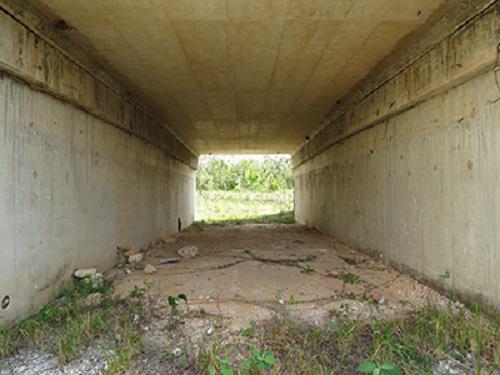Alberto González Gallina
Specific aims of the project:
-Description of the differential use of wildlife crossing structures along the NuevoXcan-Playa del Carmen highway by jaguars and other mammals.
-Wildlife underpass effectiveness assessment for the NuevoXcan-Playa del Carmen highway project and other possible crossing structures such as drainages (rectangular concrete culverts and concrete pipes).
-Comparison of efficiency of all potential wildlife crossing structures (wildlife underpasses, culverts and pipes) along the NuevoXcan-Playa del Carmen highway.
-Recommendations for wildlife crossing structure enhancement and management for future highway projects.

Wildlife underpass (3x4.5m) this one is accompanied with drift fencing to chanel wildlife inside. You can see this one has pretty clear view across the highway
The NuevoXcan-Playa del Carmen highway in Quintana Roo cuts the vegetation corridor connecting two Jaguar Conservation Units (JCUs), the natural protected areas of Yum Balaam (north) and Sian Kaan (south). The Jaguar (Panthera onca) is within the highest risk category in Mexican law (P endangered) with more than 69% of its original distribution lost within the country. For this reason, the environmental authorities conditioned the construction company (Ingenieros Civiles Asociados, ICA) to create wildlife crossing structures in order to maintain connectivity among the jaguar population and other priority mammal species (9 protected by Mexican law NOM059-SEMARNAT-20109). This is probably the first “green” highway built in Mexico in terms of wildlife crossing structures (28 underpasses and 20 rope bridges for arboreal animals) and for the amount of information gathered on the subject.
This will mean the first wildlife crossing structure assessment in the country and the first concerning jaguars along their distribution. Along its 54km, this highway counts with 28 wildlife underpasses (4x3.5m) making it one of the best examples of environmentally responsible highways we have in Mexico. Using camera traps covering wildlife underpasses (10), and drainage structures such as rectangular concrete culverts (9) and concrete pipes (9) along the 54km stretch of the Nuevo Xcan–Playa del Carmen highway. This information will prove crucial for best practice recommendations in future highway projects along the jaguar´s distribution. On this particular place, which species use them, which don´t, how often do they use them and if they have preference for a certain structure. We will then have a clearer picture if these structures are worth building in terms of cost-benefit and how we can improve them in case we find some usage pattern depending on structure and habitat traits.